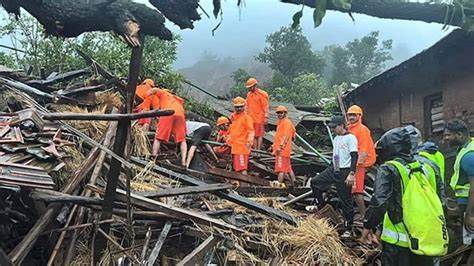Landslide kills dozens as India hit with heavy rains in July 2023

Landslide kills dozens as India hit with heavy rains in July 2023
The tragic incident occurred on a Thursday night when a massive landslide hit the remote mountain village of Irshalwadi, situated around 60 km (37 miles) from Mumbai. The landslide’s sudden and powerful impact led to a devastating outcome, as several houses were completely destroyed, leaving the community in a state of utter shock and distress.
The residents of Irshalwadi, who likely led a peaceful and serene life amidst the mountains, were unexpectedly faced with this natural calamity that caused widespread destruction and upheaval. The force of the landslide would have been terrifying and overwhelming, and the once tranquil village was now transformed into a scene of chaos and devastation.
As the news of the disaster spread, rescue and relief efforts would have been mobilized to reach the affected village and offer assistance to those trapped or injured. Emergency responders, local authorities, and volunteers would have worked tirelessly to locate survivors and provide immediate aid to the displaced and injured residents.
The community members, who may have lost their homes, possessions, and in some cases, even their loved ones, would have been in a state of disbelief and grief. The trauma and emotional toll on the survivors and families of the victims would have been immense, and they would need extensive support from government agencies, relief organizations, and counseling services to cope with the aftermath of the disaster.
The incident in Irshalwadi serves as a poignant reminder of the unpredictable and devastating power of nature. It also highlights the importance of disaster preparedness, early warning systems, and infrastructure resilience in vulnerable areas to minimize the impact of such natural disasters and protect the lives and livelihoods of communities living in at-risk regions.
In another part of western Maharashtra state, specifically in the Yavatmal district, heavy flooding caused significant challenges for the local population. The situation became dire as villages were inundated, leaving people stranded and in need of rescue. In response to the emergency, the Indian Air Force stepped in and provided assistance by deploying helicopters to rescue those trapped in the heavily flooded areas.
In the Navsari region, streets were entirely submerged due to the overwhelming floodwaters. This led to immense difficulties for people trying to navigate through the area, as their vehicles struggled to move through the waterlogged streets.
Natural disasters like landslides and floods can have devastating consequences on communities and infrastructure. The need for rescue operations, as seen in the Yavatmal district, emphasizes the importance of emergency response and support from government agencies and humanitarian organizations during such crises.
The affected communities are likely to require extensive assistance in terms of relief, shelter, and resources to recover from the disaster and rebuild their lives. Such events also serve as a reminder of the significance of disaster preparedness and mitigation efforts to minimize the impact of such calamities on vulnerable regions.
Indeed, India’s massive population of over 1.3 billion depends heavily on rainfall, especially in rural areas where agriculture is a primary livelihood for many people. Rainfall is essential for irrigation and ensuring the success of crops, and it plays a crucial role in supporting the country’s food production and economy.
However, as you pointed out, excessive rainfall can lead to several devastating consequences. One of the most common and severe issues is flooding. Heavy rains can overwhelm drainage systems, leading to inundation of low-lying areas, damaging homes, infrastructure, and crops. Floods can displace communities, disrupt transportation, and cause significant economic losses.
Another hazard associated with heavy rainfall is landslides, particularly in hilly or mountainous regions. The soil becomes saturated, losing stability and triggering landslides, which can be destructive and life-threatening.
In addition to these direct impacts, excessive rainfall can also contribute to the spread of water-borne diseases. Contaminated water sources become prevalent during floods, leading to outbreaks of diseases like cholera and typhoid, posing a threat to public health.
Managing water resources and mitigating the impacts of excessive rainfall are crucial challenges for India. The country has been working on various strategies, including building and maintaining water reservoirs, improving drainage systems, and implementing early warning systems for floods and landslides. Additionally, there are efforts to promote sustainable agricultural practices and water conservation methods to reduce the dependency on unpredictable rainfall.
As climate change continues to affect global weather patterns, the unpredictability and intensity of rainfall in India may become more challenging to manage. Adaptation and resilience-building measures will be essential to safeguarding both the livelihoods of the population and the natural environment.




